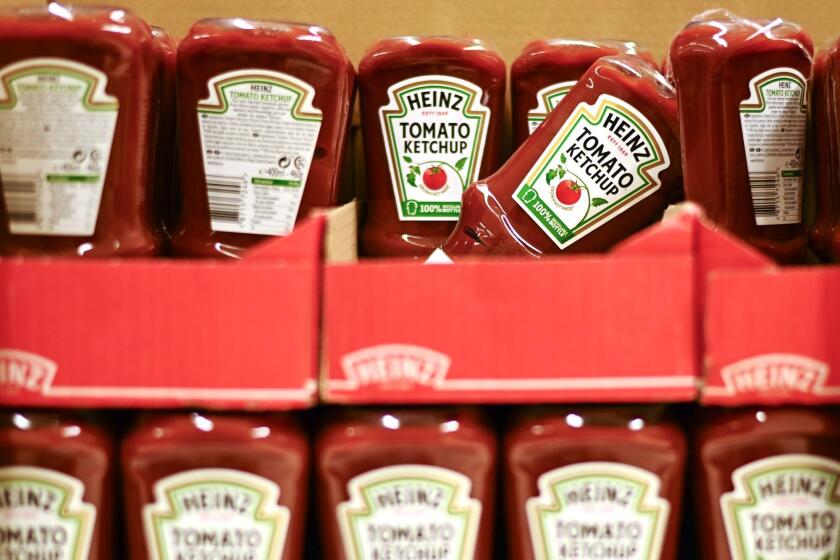Melting Pot Days at the Old Terminal Market
- Share via
Marita Hernandez’s article (July 21), covering the old and now the new Los Angeles Wholesale Market was like tonic as I recalled those very days that spanned the late 1920s that the Terminal Market at 7th and Central became a highlight in my early days in Los Angeles.
Yes, my dad had a “huckster” wagon that was used each early morning to drive from Boyle Heights (Spencer and Atlantic) west on Stephenson Avenue over to 7th Street and west again to the 7th and Central location. Here my dad loaded up with fruits and vegetables that were hawked as we drove through the streets of Boyle Heights that same day.
Then, like many others who had the opportunity to do so, my dad was able to rent a “stall” in the open at the Terminal Market where he graduated from being a “peddler” to a wholesaler who sold peaches, apricots, plums and apples during the seasons to succeeding “peddlers” who hawked the streets of Los Angeles.
Right next to dad’s stall was a “fishman” of Japanese ancestry who used to haul large boxes laden with iced fresh fish from San Pedro that the sold to everyone, but mostly to others of Japanese ancestry who were truck gardeners with loads of produce they had brought to sell to the “peddlers” the same as the rest of us. Leftover fish were then delivered to local restaurant customers awaiting his early morning delivery.
I recall with fondness the close relationship established between my dad and the “fishman” who often gave us fresh fish in exchange for fresh fruit from my dad. Yes, I learned all about the different kinds of fish “other people” ate, even “ink” fish or calamari that mom and dad remembered from Italy and were again serving at the family table.
The terminal was filled with people from Japan, Italy and Greeks and Jews and other immigrants who were following the footsteps of others in becoming “Americans.”
I went to school (the former Boyle Heights Institute, later changed to Hollenbeck Junior High) with sons and daughters of those same immigrants who were now first-born Americans. Not only was I going to school with the nationalities mentioned, but also with children of Russian immigrants who lived in “Russian Hollow” on Soto Street between Stephenson and 9th Streets at the same time Sears Roebuck was building its main plant and offices at Olympic and Boyle.
This school period also brought me in contact with Mike and John Galitzen, brothers of a Russian family whose livelihood was trash collecting. Mike later became known as Mickey Riley, an Olympic Gold Medal diving winner in the 1932 L.A. Olympics. John followed closely but did not reach the same level.
The only tinge of regret I got from the article was the mention of Dick Moreno telling of the unfair competition from families of immigrants who drive to Bakersfield and arrange to pick a farmer’s field and then return to Los Angeles to “undersell” their competitors. Sorry, Mr. Moreno, but that was the way of life in those days when families joined forces to make their way into becoming the Americans they are today. Had Moreno traced back far enough he would have found family labor was a necessary evil for the immigrant to get a foothold and then join the prosperous who have become affluent Americans of today.
Yes, I remember my dad contracting with peach, apricot, plum and fig farmers (Gardena) where our family picked ripe fruit to be sold at the stall in the Terminal Market. Our family prospered and we kids went to school, but like many “foreigners” didn’t graduate from high school to take low-level jobs to work our way up the ladder just as many did.
As I see my brothers and sisters and our counterparts from our Terminal Market days I revel in the glory of opportunities given us by virtue of our willingness and ability to work for what we wanted.
Now ask our children and grandchildren if they are not living a far better material life than our moms and dads and we first-generation kids. As I see our grandchildren getting married and starting out with a houseful of new furniture, two cars and all the electronic wonders now commonplace today, I have to laugh a little at what my wife and I did when we moved in with my mom and dad to save a few dollars needed to buy the bare and used necessities to start a home of our own.
How soon we forget our heritage.
Thanks, Marita Hernandez, for your fine article and for the bit of nostalgia given to those like me who are willingly stepping aside to make room for the true immigrant who is willing and able to put forth the necessary effort to make an honest living each step of the way up the ladder to become an American.
VINCE (MOLLO) MILLER
Tulare
More to Read
Eat your way across L.A.
Get our weekly Tasting Notes newsletter for reviews, news and more.
You may occasionally receive promotional content from the Los Angeles Times.










